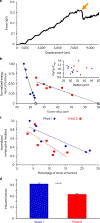Cellular packing, mechanical stress and the evolution of multicellularity
- PMID: 31723354
- PMCID: PMC6853058
- DOI: 10.1038/s41567-017-0002-y
Cellular packing, mechanical stress and the evolution of multicellularity
Abstract
The evolution of multicellularity set the stage for sustained increases in organismal complexity1-5. However, a fundamental aspect of this transition remains largely unknown: how do simple clusters of cells evolve increased size when confronted by forces capable of breaking intracellular bonds? Here we show that multicellular snowflake yeast clusters6-8 fracture due to crowding-induced mechanical stress. Over seven weeks (~291 generations) of daily selection for large size, snowflake clusters evolve to increase their radius 1.7-fold by reducing the accumulation of internal stress. During this period, cells within the clusters evolve to be more elongated, concomitant with a decrease in the cellular volume fraction of the clusters. The associated increase in free space reduces the internal stress caused by cellular growth, thus delaying fracture and increasing cluster size. This work demonstrates how readily natural selection finds simple, physical solutions to spatial constraints that limit the evolution of group size-a fundamental step in the evolution of multicellularity.
Conflict of interest statement
Competing interests The authors declare no competing financial interests.
Figures



References
-
- Buchanan M Simple yet successful. Nat. Phys 13, 720 (2017).
-
- Transtrum MK et al. Perspective: sloppiness and emergent theories in physics, biology, and beyond. J. Chem. Phys 143, 010901 (2015). - PubMed
-
- Mattingly HH, Transtrum MK, Abbott MC & Machta BB Rational ignorance: simpler models learn more information from finite data. Preprint at https://arxiv.org/abs/1705.01166 (2017). - PMC - PubMed
-
- Szathmary E & Smith JM The major evolutionary transitions. Nature 374, 227–232 (1995). - PubMed
-
- Kirk DL A twelve-step program for evolving multicellularity and a division of labor. Bioessays 27, 299–310 (2005). - PubMed
Grants and funding
LinkOut - more resources
Full Text Sources
